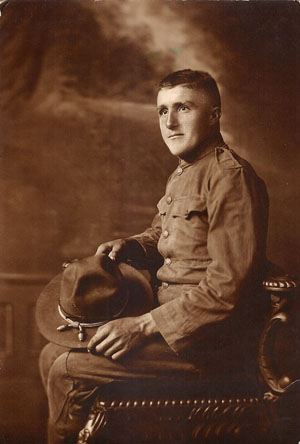

Remember...
Sidney Flemings Gatewood
1895-1918
"We were preparing not Peace only, but Eternal Peace. There was about us the halo of some divine mission. We were bent on doing great, permanent noble things."
Harold Nicolson
U.S. Army Private Sidney Flemings Gatewood, who served in World War I, was born on November 17, 1895, at Horton, Randolph County, West Virginia, to DeWitt Clinton Gatewood and Minnie May Nelson Gatewood. DeWitt and Minnie were married on January 25, 1889, and Sidney was their third child. Sidney had an older brother Willie Nathan, an older sister Russie May (Mrs. Arthur Semones), and a younger brother Charles Henry.
Pvt. Gatewood and his brother Willie were employed in Jeningston, West Virginia, by the Laurel River Lumber Company as laborers on June 5, 1917, when they registered for the initial World War I draft at Dry Fork. Both were single and living at Osceola in Randolph County. Sidney is described on his draft registration record as being of medium height and stout and having brown eyes and light brown hair. Willie was short, of medium build, and had blue eyes and dark brown hair. Sidney was assigned to Company H, 5th Provisional Battalion of Engineers. Sidney's brother, Charles Henry, registered for the draft one year later at Harrisonburg, Rockingham County, Virginia, where he was employed as a farm laborer. His draft registration describes him as being of medium height and medium build with grey eyes and light brown hair. Charles Henry was not called to military service.
In May 1917 an Army training camp was established at Fort Benjamin Harrison to train men to become officers in the reserve corps to lead American troops on the battlefields in France. The new officers provided training for thousands of recruits at the fort. Pvt. Gatewood reported to this post.
During October 1918 the Spanish influenza-pneumonia pandemic reached its height. Although American soldiers received inoculations for other diseases, such as smallpox, no inoculation was available at the time for influenza. It is estimated that over 675,000 Americans died during the influenza-pneumonia pandemic, and more than 43,000 soldiers died of this particularly virulent strain of the respiratory illness during World War I. Many victims died within hours of displaying symptoms. Others died of pneumonia after only a few days when their lungs filled with fluid, resulting in suffocation. The hospital saw its first cases of influenza on September 24, 1918. There were 203 cases admitted on that day. By October 9 there were 1,701 patients in the hospital, which had only 400 beds. The hospital set up barracks wards and 25 tents to accommodate the overload. On October 9 there were 264 cases of secondary pneumonia.
On October 8, 1918, at Fort Benjamin Harrison, Pvt. Sidney Flemings Gatewood succumbed to influenza. An article in the Elkins Inter-Mountain ("Influenza Invades Whitmer-Horton"; 17 Oct. 1918) implies that Sidney Gatewood was among the local victims of the epidemic, although a previous notice in the same newspaper (12 Oct. 1918) states that "Sydney [sic] Gatewood of Horton is dead at an Indiana camp." Subtitled "Special Surgeon from Washington, D. C., Arrives to Relieve Situation," the October 17 article reflects a scenario that was playing out in communities throughout the western world:
Dr. F. H. Massey, A. A. Surgeon of Washington, D. C., arrived here yesterday on the evening train and has been very busy calling ever since. He slept some last night in latter part of the night. He wired the chief of surgeons of Washington, D. C., today making these statements: "I arrived here last evening, October 15. I find all the community down. Mostly Spanish Influenza and pneumonia. Send nurse at once. Send the necessary quinine and extracts." He ordered a lot drugs forwarded at once. He stated in his message that seventeen have died in the last ten days.
Pvt. Sidney Gatewood was returned to his native West Virginia for burial in the Nelson Family Cemetery near Whitmer. Younger brother Charles died nine days later, another victim of Spanish influenza, and was also buried in the Nelson Family Cemetery.
Article prepared by Leon Armentrout, whose maternal grandfather was a first cousin to Sidney Gatewood's mother, with editorial assistance from Patricia Richards McClure.
February 2015

West Virginia Archives and History welcomes any additional information that can be provided about these veterans, including photographs, family names, letters and other relevant personal history.